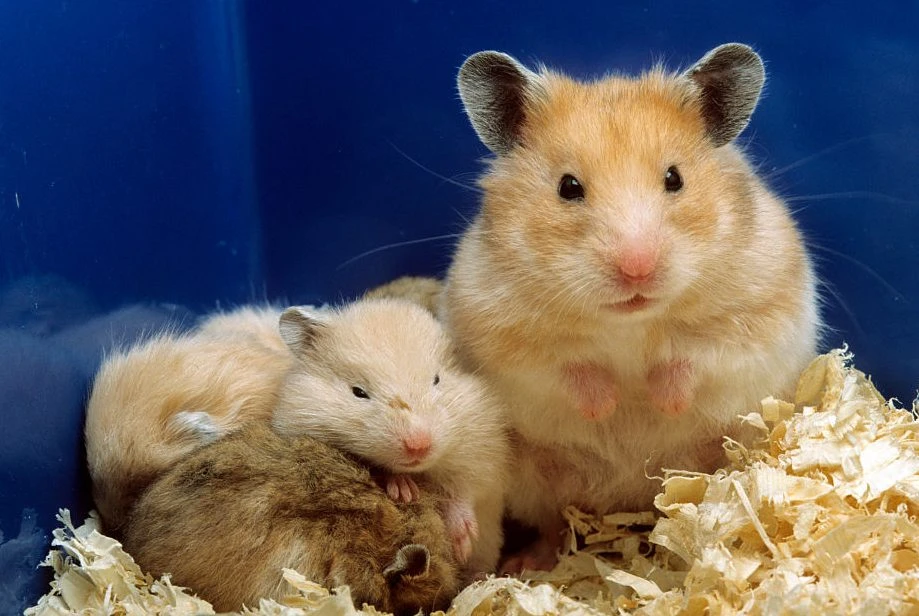If you’re thinking about getting a hamster as a pet, you’ll want to know how long it will last.
Pet hamsters have a two-to-three-year lifespan on average. The Roborovski hamster, with a lifetime of up to 3.5 years, is the longest-living pet hamster.
By providing the greatest possible care for your hammy, you can influence how long he or she will live.
To help you better understand how long hamsters can live, we’ll go into greater detail in this article, and we’ll also offer some advice on how to ensure that yours does, too.
Hamster Life Cycle
When it comes to hamster life stages, they aren’t long-lived creatures. They are completely blind and deaf when they are born.
The name given to newborn hamsters is “pups,” which are exceedingly delicate.
- They begin to grow fur at five days.
- They opened their eyes after two weeks.
- Hamsters often remain with their mothers for 21 to 28 days after birth.
- Hamsters become sexually mature between the ages of four and six weeks.
- They should not be bred until they are at least 8-12 weeks old or weigh between 90-100 grams.
- Ideally, short gestation lengths of 20–22 days are typical. Hamsters can no longer reproduce at the age of 14 months.
Hamsters can expect to live between 18 and 36 months on average, with Syrian hamsters being the most likely to survive. It is termed old age if a hamster is more than 18 months old.
It’s always a good idea to think about a pet’s longevity, especially if you have children.
Depending on where they live, how well they are cared for, and if they have any predators, each hamster breed or species has a distinct lifespan.
These are known as the “Golden Hamsters” or “Syrian Hamsters.” Among hamsters kept as pets, this is the most prevalent variety.
They’re golden brown in color and range in length from 4.9% to 6.9% of the average adult human height. They have a lifespan of two to three years.
The Russian Dwarf by Campbell. Their lifespan is between 1.5 and 3 years; they are also referred to as Russian Dwarf Hamsters.
Normal, smooth, wavy, and rex coats are available, with a length range of 3.9-4.7 inches. native to Asia and China’s northeastern region.
There are two species of dwarf hamsters known as the Djungarian Hamster: the Winter White Russian Dwarf and the Djungarian Hamster.
The summer coat might be brownish-gray or bluish-gray, but it turns white when it molts. They are well-known for their fur. Originally from Siberia, Mongolia, and Kazakhstan.
The Chinese hamster, which is usually 2 to 3 years old, is also known as the Rat Hamster.
Long and skinny with a long tail, these fish are between the lengths of 39 and 47 inches.
A black stripe runs along their spine in a greyish brown color. This species is indigenous to northern China and Mongolia.
The Roborovski hamster can live up to three and a half years, and they can measure between 1.8 and 2 inches in length.
The Gobi Desert, Mongolia, China, and Mongolia are all home to this species of antelope.
The average longevity of a hamster was only 18 months, despite the fact that approximately a quarter of members said their animals lived to be older than two years.
A very small percentage of hamsters survived into adulthood.
Wild European Hamsters have a lifespan of up to eight years. As a fun fact, it is a distinct species from the common pet hamsters.
As a hamster owner, you may take steps to ensure that your adorable rodent has an enjoyable and long life.
What Makes Some Hamsters Live Longer Than Others?

Domesticated hamsters, like many other animals, live longer lives than their wild counterparts.
Environmental factors and competition with other hamsters might shorten their lives. With correct housing, handling, diet, and veterinary care, hamsters can survive much longer in captivity.
Domesticated hamsters are prone to disease and other health concerns that can have a substantial impact on their lifespans as frail and sensitive pets.
As an example, a pet hamster may suffer from diarrhea as a result of stress within the first few weeks of ownership (often between 3 and 10 weeks). Diarrhea, on the other hand, can happen at any age.
Hamsters may also lose their fur due to a lack of nourishment. Hamsters are susceptible to a variety of other illnesses, including:
- Eye proptosis
- Mites
- Ringworm
- Cheek pouch disorders
- Heart disease
- Kidney disease
- Diabetes
- Dental problems
- Cancer
- Amyloidosis (protein deposits in the organs)
Glaucoma is also more common in Djungarian hamsters. Heart disease, amyloidosis, and pneumonia are all prevalent ailments in Syrian hamsters.
These disorders can be prevented or delayed with adequate nutrition and care.
How Can I Make My Hamster Live Longer?
You can help your hamster live a longer and healthier life by feeding, housing, and caring for them properly.
Commercially available pelleted rodent food intended for mice and rats should be the hamster’s primary source of nutrition.
It is possible to be deficient in the vitamins, minerals, and amino acids that can be found in a diet based exclusively on seeds.
Grains, fruits, and vegetables can be given to your hamster on rare occasions as rewards if you provide him with a well-balanced diet.
Avoid foods that are high in refined sugar and poor in fiber in order to help your hamster live a long life.
Hamsters, like all rodents, require a lot of room to run around. A wide variety of cages are suitable for your pet.
Resilient polycarbonate, polysulfone, and polypropylene or stainless steel commercial cages are ideal.
Cages constructed of wood or soft metals like aluminum are not advised for hamsters since they want to chew and escape.
The ideal hamster cage size is large enough to include a nest box, an exercise wheel, and other enrichment for your pet. 24″x12″x16″ is the most common, but other sizes are also available.
It’s always best to go large. Your hamster will live longer if you give him or her plenty of room to run around and have fun.
To prevent escape, cages should have a sturdy, tight, and close-fitting door and lid.
A solid-bottomed cage with bedding is ideal for hamsters. To avoid irritating hamsters, bedding should be absorbent, non-toxic, and largely dust-free.
Wood shavings or chips, corn cob, pelleted wood, and recycled paper goods are also good options. Cedar and other untreated softwoods, like pine, have been linked to hamster liver disease.
Because hamsters tend to eliminate one area of the cage, it is necessary to change the dirty bedding every day and replace it with a clean one.
Enclosures and bedding should be sterilized at least once every two weeks, if not more frequently.
Hot water and a nontoxic disinfectant or detergent should be used to properly sanitize cages. Daily cleaning and disinfection of water bottles and food plates are recommended.
It is also a good idea to add tubes, exercise wheels, pipes, shelters, and tunnels to your hamster’s cage to provide enrichment and stimulation.
For your hamster’s comfort, you can provide tissue paper, cotton, or paper towels.
Finally, to ensure a happy and healthy hamster, keep the temperature in the room between 68 and 79 degrees Fahrenheit, with a humidity level of 30 to 70 percent.
Even though hamsters aren’t as durable as other pets like cats or dogs, they can still be great pets for any home.
Healthy daily hamster care practices, together with frequent vet checkups, can help extend the life of your hamster.
How To Tell If My Hamster Is Getting Old?
You may not know how old your hamster is if you didn’t obtain him as a newborn. However, there are a few telltale signs that he is becoming older.
Your hamster’s activity level will decrease. In addition, it’s possible that he will lose interest in treats altogether. His eating habits and weight will be less stable as a result of these swings.
His vision, hearing, and hair loss can be clearly seen. It’s possible that his teeth aren’t functioning as well as they once did.
Moving food, water, and other necessities closer to where he sleeps can help alleviate these symptoms. If a ramp is too steep, you may want to eliminate it.
If you can, keep him in a peaceful atmosphere, and don’t catch him off guard when you go in to handle him. Pellet food can be made softer by adding water to it.
Who is the oldest living hamster?
According to the Guinness Book of World Records, a hamster in the United Kingdom lived for 4.5 years before it was put down. The type of hamster is not mentioned.
A striped dwarf hamster can live up to 5.3 years, according to scientific data from zoo collections.
According to the same research, the Syrian or golden hamster had a life expectancy of 3.9 years.
Many people claim that their hamsters live longer than the study shows if you do a search on the Internet.
Syrian hamsters have been known to live up to 6.5 years, according to some reports.
Anecdotal information suggests that some hamsters are older than expected, but their owners aren’t reporting it to the appropriate authorities.
Watch Out For Disease – Especially Wet Tail Disease
A wet tail is a frequent hamster ailment that is caused by bacteria in the intestines. The most obvious sign is a wet tail, which is often coated with excrement as well.
It’s possible that other signs include tiredness and a lack of food as well as excessive slumber, curled ears, and an unpleasant smell. This can kill your hamster if it isn’t treated within the first 24 to 48 hours.
Avoid getting your hamster’s tail wet. There are many factors that can contribute to wet tail illness, such as inadequate cleanliness, overfeeding, stress, and insufficient water quality.
Try to keep your hamster from suffering from diarrhea if you can. A virus, too many greens or laxative meals, unsanitary living circumstances, or stress are all potential causes.
Soft, watery, and less dense feces will be produced by the hamster. It will also get lethargic and look sick. They may also experience a reduction in their body mass.
Going to the vet will help, but if you wait too long, your hamster may be in pain for a longer period of time.
Spend some time with your hamster at the end of the day. The more you observe your hamster, the more you’ll be able to tell when something is off or out of the ordinary.
How Long Do Hamsters Live Compared To Other Pets?
The bad news is that hamsters don’t live very long compared to other pets.
They do, however, quite well in the world of rodents. Even though mice and rats only survive for around a year or two, hamsters can live for up to five years.
There are a number of common home pets, including dogs and cats, goldfish, rabbits, guinea pigs, reptiles, and parrots.
Taking a look at their lifespans, let’s see how they stack up:
- Hamsters’ lifespan is the closest to that of the lizard or guinea pig, with a minimum lifespan of three years.
- Between five and ten years, goldfish can survive.
- 9 years is the average lifespan for snakes.
- Rabbits can live for seven to ten years.
- Dogs, man’s best friend, have an average lifespan of 8 to 13 years, though they have been known to live considerably longer.
- Outdoor cats have a shorter lifespan, with an average lifespan of only five years, compared to indoor cats’ 18-year lifespan.
- A parrot can live up to 50 years, making it the longest-lived pet on our list.
- Up to 25 years can be lived by cockatiels.
- Up to a total of eight different species of parakeet can be found.
Do some study before you get a hamster. Some of the toys are so little and delicate that they are not advised for toddlers under the age of two.
Make certain your hamster has a healthy and comfortable existence by taking the required actions and precautions.
It’s not just how long your pet lives that matters; it’s how well you care for your pet during that time that matters most.
Keeping your hamster happy and healthy is a terrific way to develop a lifelong bond with your pet.






